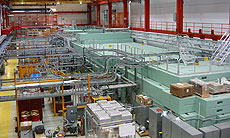Fermilab's golden rule: What goes around comes around
 |
| The SRF Test Facility at NML is filled with recycled materials. The green shield blocks, cable tray and yellow electrical racks are all reused equipment. Photo: Jerry Leibfritz
|
Some people make coffee coasters out of old newspapers or lawn ornaments out of rusty shovels. Fermilab is building a particle accelerator that employs $28 million of recycled equipment and material.
Fermilab's Superconducting Radio Frequency program places Fermilab at the forefront of design and development for the next generation of particle accelerators. To develop the SRF program infrastructure, scientists and engineers are incorporating old equipment into its new designs. A significant portion of the machinery, metal and concrete the SRF program uses for its test facility was reclaimed, revamped and refurbished from old experiments. The SRF program also uses preexisting buildings on site to build and house various components of the program.
SRF program Director Bob Kephart is proud of the reuse and recycle tradition at Fermilab.
"Reusing parts and machinery is a win-win: it's quick, environmental, saves money and it's smart," Kephart said. "If we can use something that's already here and refurbish it for our own purposes, it's a lot easier and faster than building something from scratch."
Engineers designing the facility scoured Fermilab's railhead, a storage yard used to house unneeded materials until another experiment or project finds a use for them. Fermilab personnel also contacted other laboratories, like Jefferson Laboratory and SLAC, looking for all the right parts. One piece of machinery they are particularly excited about is a helium purifier that they will be getting from PPD.
"There is a lot of trading between the experiments, and whenever we can get a piece of equipment that we can use, we are very appreciative," said Jay Theilacker of the Cryogenic Department.
Because budgets are limited, Fermilab engineers like those working on the SRF project must be creative when planning an experiment.
"No experiment ever has as much money as it would like. We look around and see what material is available and then we design the project around what we have," project leader Jerry Leibfritz said.
One example of creative recycling is the SRF beam absorber that contains 800 tons of concrete and 600 tons of steel handpicked from the railhead.
"This steel may have originally been part of a battle ship that Fermilab acquired the steel from many years ago," Leibfritz said.
"It doesn't float anymore," Theilacker added.
Leibfritz and Theilacker pointed out one refrigeration unit that perfectly depicts the DOE's reuse and recycle tradition.
"We call this the SLAC refrigerator, but originally SLAC got it from Los Alamos. The government has really gotten its money's worth on this unit," Theilacker said
But before any equipment, like the SLAC refrigerator, is incorporated into the experiment, it undergoes refurbish boot camp. Reclaimed material is sand blasted, scrubbed, repaired and repainted. The engineers also look for ways to make the equipment more efficient. These efforts keep the machinery in tip-top shape and extend the equipment's lifetime.
Eric Mieland and Katie Kosirog of ES&H monitor the materials diverted from becoming waste. For them, recycling and reusing old equipment demonstrate the laboratory's commitment to working in an environmentally sound manner.
"We cannot recycle any metal that has been exposed to radiation. If we don't reuse that machinery, it may end up as a regulated waste that is both costly and labor intensive to dispose. Reusing old equipment is a creative way to deal with this material," Mieland said.
Kosirog is responsible for tracking the different recycling programs at Fermilab and nominated the SRF project for the DOE's E-Star award for Integrative Planning and Design.
"Historically, we have had a focus on reusing material, and this project aptly exemplifies this attitude," Kosirog said.
This award highlights experiments that "emphasize cross-cutting collaboration to advance sustainability goals in the planning and design phase." Even if the SRF program doesn't win this prize, it still benefits substantially from smart planning and creative reusing.
—Sarah Charley
|